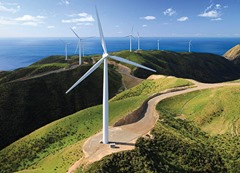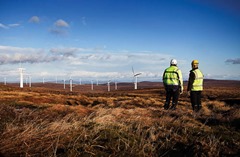Community acceptance and the future of wind energy
 Governments and developers have neglected the views of communities in the drive to increase onshore wind power, Professor Geraint Ellis argues. The alternative is to actively involve the public in energy policy and make sure the benefits are fairly shared.
Governments and developers have neglected the views of communities in the drive to increase onshore wind power, Professor Geraint Ellis argues. The alternative is to actively involve the public in energy policy and make sure the benefits are fairly shared.
For at least the last twenty years, academics have been highlighting the need to understand that a successful decarbonisation of our energy systems is as much dependent on understanding social relationships around energy as getting the hard wiring and actual physical renewable projects on the ground.
This is particularly true on the island of Ireland, as its major exploitable renewable resource is currently onshore wind, a sector that tends to attract community unease in almost every country it is developed.
It is clearly logical that Ireland, North and South, should reap the benefits of its huge wind resources. In a world threatened by the consequences of fossil fuel exploitation, such as climate change, oil price fluctuation, peak oil and geo-political instability, it clearly makes little sense to continue to import virtually all energy to Ireland when it has such an expansive wind resource.
Technology first
This has been clearly recognised by the island’s two jurisdictions and over the last 10 years there has been an incredible expansion of the generating capacity of the wind energy sector, leading to significant economic and environmental benefits. This expansion has been dominated by the idea that the development of wind energy projects is largely an issue of simply rolling out a programme of hard infrastructure.
This technological approach faces its own challenges: getting aspects of financial viability right; reducing risks to acceptable levels; investing appropriately in the grid; and having planning policies that can facilitate the appropriate decisions. However, this approach can only deliver so much because renewable development actually takes place in a society populated by people – people who may be suspicious of such a programme, sceptical of the motives of developers, or see the changes to cherished landscapes as too high a price to pay for the benefits of wind energy.
The consequences of this have not been fully grasped, with governments and developers neglecting the social dynamics around wind energy projects in Ireland, largely because opposition groups were small, scattered and ineffective, particularly compared to the level of objection seen in some of our neighbours.
The implications of this are now starting to emerge with a range of symptoms. The most obvious is the up-swell of opposition to the ambitious ‘energy for export’ project in the Irish Midlands but we can also point to private member’s bills in the Oireachtas aiming to extend setback distances between turbines and residential properties, the launch of a major inquiry in the Northern Ireland Assembly on the planning of wind energy, and the increasing voice and organisation of island-wide opposition groups.
These are not issues that can be ignored. The idea that Ireland can develop a robust long-term wind energy sector by pushing through individual projects against the wishes of local groups and then move on to the next site is – and always has been – folly. Expressions of social concern have the potential to severely constrain, even reduce, the viability of the Irish wind industry. Indeed, I have long argued that the ultimate capacity of wind energy in Ireland will not be defined by the physical parameters of the wind resource or the capacity of the grid, but by how many turbines people north and south of the border are prepared to put up with.
It is a mistake to see the impact of opposition to wind projects in terms of the problems faced by individual planning applications. A single high profile case can have major repercussions for the industry. A good example of this is from Denmark. Here, while the public has been traditionally very supportive of wind, the proposal to develop a major national testing site at Osterlid was handled so poorly in terms of community engagement and siting with respect to environmental designations, that it generated high levels of opposition that in turn attracted much negative media coverage.
As a consequence, it seemed to turn the idea of large scale wind energy toxic so that projects hundreds of miles away suddenly began facing scepticism and hostility. Here the poor practice of a single developer has had important implications for the entire industry.
The example of England is also illustrative as it highlights some of the political consequences of grassroots objections. England has had long-standing local opposition activity but with the election of the Conservative-led coalition in 2010, these voices of objection have gained a direct line to central government and are now resulting in declining support for wind energy.
Conservative MPs, in general, tend to be more sceptical about wind energy (and indeed climate change) and many of them feel electorally threatened by UKIP, which has a strong anti-wind stance. This has hardened the Conservative stance and a result of this has been a reduction in the subsidy offered to onshore wind schemes, a planning policy that gives communities a greater say in rejecting planning applications for wind projects, and a shift to nuclear as a key element of the decarbonisation strategy. These all have had a substantial impact on the long-term prospects for the English wind energy industry.
Social concept
No-one can predict whether either part of Ireland could follow a similar trajectory but it is possible to envisage a range of scenarios ranging from, in the worst case for the wind industry, a moratorium on any further projects to the best case for the industry where local communities become so convinced of the benefits that they compete to attract wind energy projects.
In between such unlikely extremes, we can imagine a series of scenarios that may involve future projects limited to the redevelopment of existing sites, or local variation where some parts of the island buy in to wind whilst others reject it outright. Whatever the most likely scenario, it is becoming increasingly clear that the social aspects of wind energy in Ireland have not been particularly well-handled and they are beginning to have some significant consequences.
To begin to understand what can be done about this, I come back to the need to view energy as much a social concept as one to do with infrastructure and targets. For example, the barriers to the ambitious 40 per cent renewable targets for electricity have always been envisaged in relation to the need to secure private sector investment or upgrades to the gird, never in terms of whether local communities are prepared to put up with them.
Indeed, as far as I am aware, the targets were drawn up with no notion of the number and distribution of turbines across the Irish landscape and when it is seen in these terms, it becomes quite clear that it will involve the complicity of a lot more than some major industrial interests to achieve the target.
Similarly, governments and industry focus their attention, in a rather condescending way, on delivering a community benefits ‘package’ for individual schemes. While I recognise that such schemes do have some positive dimensions (although paid at a much lower level in Ireland compared to Scotland), they are not a particularly good strategy for delivering a substantial shift in public attitudes to wind projects and, in some cases, may be just seen as a bribe and thus have the opposite effect.
It is time for the governments north and south of the border to think far more imaginatively about how they can convince the public that it is in everyone’s interest that the island has an energy future based on wind and other renewables. This should not be aimed at suppressing or eradicating opposition to wind – in any case an unrealistic and pointless task – but about engaging the public in shaping an energy policy where the trade-offs are realistically recognised and the benefits fairly shared.
I would argue that this can only be effectively done by developing a more holistic energy transition plan, an Irish version of Germany’s Energiewende. This needs to recognise that the development of a robust and sustainable energy future for the island involves far more that setting renewable energy targets, and involves large scale technological change (e.g. involving energy storage, electrification of transport etc.) and a socialisation of energy.
These social aspects can only ultimately be defined through community engagement but aspects could involve substantial investment in community ownership of renewables, devolving carbon budgets to individual communities, enhanced community input to national energy strategies or even major paradigm shifts by nationalising renewable resources in a declaring them communal resources for which royalties should be paid.
The possibilities are infinite and while many of these aspects may be already being explored incrementally by different agencies, there is no sense that either part of the island yet has a full sense of its long-term energy future, and most critically, does not grasp the role of the people in delivering it.
Professor Geraint Ellis is Chair of Environmental Planning at Queen’s University Belfast.







